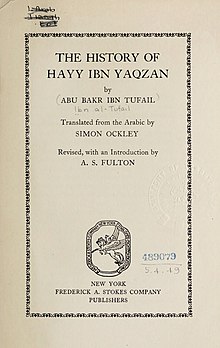哈義·本·葉格贊的故事
| 哈義·本·葉格贊的故事 | |
|---|---|
 1708年英譯本扉頁 | |
| 原名 | حي بن يقظان |
| 作者 | 伊本·圖費勒 |
| 類型 | 哲學 |
| 語言 | 阿拉伯語 |
| 發行資訊 | |
| 出版地點 | 西班牙 |
《哈義·本·葉格贊的故事》(阿拉伯語:حي بن يقظان Ḥayy ibn Yaqẓān),阿拉伯文哲學寓言小說,作者是12世紀阿拉伯穆斯林博學家伊本·圖費勒[1]。其拉丁文譯本名為《自修的哲學家》(拉丁語:Philosophus Autodidactus)。哈義·本·葉格贊這一名字是小說的主人公,取自伊本·西那的著作[2][3]。小說講述了一個無人島上的野孩子在瞪羚撫養下,通過自主學習逐步悟出哲學真理的故事。小說極大地影響了伊斯蘭哲學乃至啟蒙時代哲學的發展[4]。
情節
[編輯]哈義是東印度群島中一座無人島上成長起來的野孩子,無父母,由瞪羚撫養長大。哈義只學會走路,會模仿瞪羚、鳥類等周邊動物的叫聲。他理解了動物們的語言,也習得了動物們的本能行為。他用動物皮做鞋子和衣服,還開始觀測星體,逐漸習得大量天文學知識。他不斷觀測周邊的生物和環境,從而掌握了大量自然科學、哲學和宗教的知識。他得出結論:造物主必定存在。哈義決定清心寡欲地生活,只吃素食,像蘇菲行者一般。哈義在30歲時遇到了他見到的第一位人類,是為一個遭遇海難的逃難者。到49歲,他有了很高的哲學造詣,可以教化他人。
觀點
[編輯]伊本·圖費勒在《哈義·本·葉格贊的故事》以寓言的形式表達了其哲學觀點[5]:
- 人類僅憑觀察和思考自然世界,足以達到先知的造詣水平,後天教育並非必需。
- 通過觀察、實驗和推理獲得的信息與宗教啟示不相矛盾。換句話說,宗教和哲學(或科學)是兼容的,而不是矛盾的。
- 獲得真理是個人的事情,每個人都可以做到。
- 宗教的外化掩飾,如偶像崇拜、物質依賴等,是普羅大眾必需的,這是為了讓他們有着體面的生活。但偶像和物質是阻礙求真的混淆品,發覺了這一點的人就應該拋棄它們[6]。
影響
[編輯]伊本·圖費勒寫作此小說也是為了呼應安薩里的著作《哲學家的矛盾》。伊本·納菲斯在13世紀著成小說《自修的神學家》呼應此作。《自修的哲學家》是阿拉伯文學歷史上的名著,在歐洲文學也有着非比尋常的影響力[7],在17世紀和18世紀成為西歐暢銷書[8][4]。此作顯著地影響了伊斯蘭哲學和近代西方哲學的發展[9],被視為激發科學革命和啟蒙時代的先驅之作,其中的思想在托馬斯·霍布斯、約翰·洛克、艾薩克·牛頓、伊曼努爾·康德的著作中都有體現[10] 。
該書的拉丁文版《自修的哲學家》最早出現在1671年;首部英文譯本出版於1708年。該作也激發了丹尼爾·笛福的靈感,促使他創作出《魯濱遜漂流記》,同樣講述了一個無人島上的倖存者的故事[11][12][13]。小說也促使了威廉·洛克之《人類理解論》中白板概念的誕生[4]。書中哈義的唯物主義觀念和卡爾·馬克思的歷史唯物主義也有一定相似之處[14]。該書還預示了後世提出的莫利紐茲問題[15][16]。戈特弗里德·萊布尼茨[7]、約翰·沃利斯、克里斯蒂安·惠更斯[17]、貴格會[18]、伏爾泰[19]的思想也都受到此書影響。
參見
[編輯]參考文獻
[編輯]- ^ Kukkonen, Taneli. Ibn Ṭufayl’s (d. 1185) Ḥayy ibn Yaqẓan. El-Rouayheb, Khaled; Schmidtke, Sabine (編). The Oxford Handbook of Islamic Philosophy. November 2016 [2 January 2018]. (原始內容存檔於2021-06-09).
- ^ Nasr, Seyyed; Leaman, Oliver. History of Islamic philosophy. Routledge. 1996: 315. ISBN 0415131596.
- ^ Davidson, Herbert Alan. Alfarabi, Avicenna, and Averroes, on Intellect Their Cosmologies, Theories of the Active Intellect and Theories of Human Intellect. Oxford University Press. 1992: 146. ISBN 9780195074239.
- ^ 4.0 4.1 4.2 G. A. Russell (1994), The 'Arabick' Interest of the Natural Philosophers in Seventeenth-Century England, p. 228, Brill Publishers, ISBN 978-90-04-09888-6.
- ^ Özalp, N. Ahmet. Hay bin Yakzan. Yapı Kredi Yayınları. ISBN 975-363-475-7.
- ^ Corbin, Henry. Ibn Ṭufayl (d. 580 AH/1185 CE). Encyclopedia of Philosophy. 2006, 4: 550–551 –透過Gale eBooks.
- ^ 7.0 7.1 Martin Wainwright, Desert island scripts (頁面存檔備份,存於網際網路檔案館), The Guardian, 22 March 2003.
- ^ Avner Ben-Zaken, Reading Hayy Ibn-Yaqzan: A Cross-Cultural History of Autodidacticism (Johns Hopkins University Press, 2011). ISBN 978-0801897399.
- ^ G. J. Toomer (1996), Eastern Wisedome and Learning: The Study of Arabic in Seventeenth-Century England, p. 218, Oxford University Press, ISBN 0-19-820291-1.
- ^ Samar Attar, The Vital Roots of European Enlightenment: Ibn Tufayl's Influence on Modern Western Thought, Lexington Books, ISBN 0-7391-1989-3.
- ^ Nawal Muhammad Hassan (1980), Hayy bin Yaqzan and Robinson Crusoe: A study of an early Arabic impact on English literature, Al-Rashid House for Publication.
- ^ Cyril Glasse (2001), New Encyclopedia of Islam, p. 202, Rowman Altamira, ISBN 0-7591-0190-6.
- ^ Amber Haque (2004), "Psychology from Islamic Perspective: Contributions of Early Muslim Scholars and Challenges to Contemporary Muslim Psychologists", Journal of Religion and Health 43 (4): 357–377 [369].
- ^ Dominique Urvoy, "The Rationality of Everyday Life: The Andalusian Tradition? (Aropos of Hayy's First Experiences)", in Lawrence I. Conrad (1996), The World of Ibn Tufayl: Interdisciplinary Perspectives on Ḥayy Ibn Yaqẓān, pp. 38–46, Brill Publishers, ISBN 90-04-09300-1.
- ^ Muhammad ibn Abd al-Malik Ibn Tufayl and Léon Gauthier (1981), Risalat Hayy ibn Yaqzan, p. 5, Editions de la Méditerranée:[1] (頁面存檔備份,存於網際網路檔案館)
"If you want a comparison that will make you clearly grasp the difference between the perception, such as it is understood by that sect [the Sufis] and the perception as others understand it, imagine a person born blind, endowed however with a happy natural temperament, with a lively and firm intelligence, a sure memory, a straight sprite, who grew up from the time he was an infant in a city where he never stopped learning, by means of the senses he did dispose of, to know the inhabitants individually, the numerous species of beings, living as well as non-living, there, the streets and sidestreets, the houses, the steps, in such a manner as to be able to cross the city without a guide, and to recognize immediately those he met; the colors alone would not be known to him except by the names they bore, and by certain definitions that designated them. Suppose that he had arrived at this point and suddenly, his eyes were opened, he recovered his view, and he crosses the entire city, making a tour of it. He would find no object different from the idea he had made of it; he would encounter nothing he didn’t recognize, he would find the colors conformable to the descriptions of them that had been given to him; and in this there would only be two new important things for him, one the consequence of the other: a clarity, a greater brightness, and a great voluptuousness."
- ^ Diana Lobel (2006), A Sufi-Jewish Dialogue: Philosophy and Mysticism in Baḥya Ibn Paqūda's Duties of the Heart, p. 24, University of Pennsylvania Press, ISBN 0-8122-3953-9.
- ^ G. A. Russell (1994), The 'Arabick' Interest of the Natural Philosophers in Seventeenth-Century England, p. 227, Brill Publishers, ISBN 978-90-04-09888-6.
- ^ G. A. Russell (1994), The 'Arabick' Interest of the Natural Philosophers in Seventeenth-Century England, p. 247, Brill Publishers, ISBN 978-90-04-09888-6.
- ^ Tor Eigeland, The Ripening Years (頁面存檔備份,存於網際網路檔案館), Saudi Aramco World, September–October 1976.
